I REMEMBER EARLE C. ANTHONY
By Newcomb Weisenberger
|
Earl C. Anthony was born on December 18, 1880. In 1897 he built a working
electric car. Becoming interested in radio, he constructed a 50 watt transmitter
on a breadboard and begain broadcasting as KFI on April 16, 1922. His primary
business was as a California Packard distributor which was located at Wilshire
and LaBrea in Los Angeles.
Among his "claims to fame" were that the
first Neon sign in Los Angeles was erected on the roof of the Packard showroom,
and that he "invented" the chevron emblem used at his service station
and this emblem was later used on Standard Oil's Chevron stations.
His main interest, though, was in KFI (and later KECA which he purchased in 1929). He
also built one of the first post-war TV stations, KFI-TV, channel 9, and if
memory serves me, this was one of the earliest to begin color programming. KFI-TV
became KHJ-TV later. Earl C. Anthony died in 1962.— Editor. |
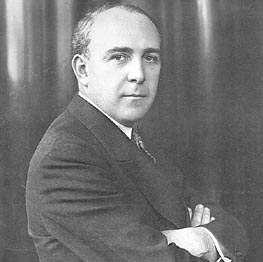
Earl C. Anthony
Earl C. Anthony's voice |
We are looking back
through more than fifty years. I am Mr. Anthony's youngest engineer and a
temporary one at that. Mr. Anthony is gray already and my flattop is still dark.
Mr. (Mac) McDonald, Studio Engineering Supervisor, is looking at my Operator's
license. He reads a total of five years experience at KGFW and KMA. Mac. Is
shaking his head in disappointment but hires me temporarily anyway. KFI Vacation
relief takes six months and he needs three new men.
I am pleased to work at a
"big" station, where there is enough money to buy new tubes when they
are needed and to hire real announcers! KFI has a maintenance department too. We are
paid if we need to work at night!
KFI has colored stripes along the halls that,
when followed, take you from the lobby to the various studios, Blue for B and
Coral for C.
We engineers are responsible for one program at a time. It is a new
thing for me to switch from place to place, sharing the program channel as it
moves through the studio complex during the day.
Each of our mixers has a copy
of the Blue Danube waltz. This is to be played on the air, whenever Mr. Anthony
asks for it. It is his favorite.
The circular, main lobby wall opens for the
telephone switchboard. Its position allows Thelma, our receptionist, to see the
people as they come in from Vermont. A small red light on her board indicates
when Mr. Anthony is not to be disturbed by calls. A ship's lantern hangs over
his office door. No one knocks when it is lighted! Here now in 2001 the same
lantern burns in my office. I still feel that it is his.
Mr. Anthony has a car
phone. I know of no other person with a car phone. Sometimes Mr. Anthony parks
on 141 North Vermont Avenue—KFI's address—and calls in, just for the fun of it.
He has just built TV Channel 9, next door south and our shop has removed the
cabinet from a small Emerson TV and has installed it behind the front seat of
his car. He is driven by his own chauffeur.
Mr. Anthony is very interested in
Palm Springs. He loves the calliope and provides one for the City's street
parade. He arranges for KFI to cover the parade live.
One Sunday morning he was
listening from Palm Springs while we're operating our 5,000-watt stand-by
transmitter. He calls master control. Dick Bull answers. Master Control (M.C.)
is a very busy place and E.C.A. wants to know why the KFI signal strength is so
low. Dick hurriedly says," It's too technical to explain." Some twenty
minutes later I passed through M.C. again and Dick is saying," Yes Mr.
Anthony."
Later Dick tells me that Mr. Anthony had recited the whole story
of how he was an engineer too and had built he first transmitter himself!
Master Control is located at a hub of doorways leading to the various studios.
Engineers can quickly move through to the various mixers. Here too is a men's
room. (It will be years before KFI hires a female engineer.)
There are times
when M.C. cuts away from NBC to substitute California commercials. This requires
close monitoring of cues. I ask Thelma to hold calls and lock the door to the
main hall. One of these times there was knocking on the door. When I can open
it, there stands Mr. Anthony with a small tour of his own! "Why is this
door locked?" "I am trying to stop traffic through here." He
understands. He and his group didn't interfere with the program cut away.>/p>
I don't think that he had his own private rail car. Mr. Anthony did put his floor
model RCA radio receiver in a lounge car. Our shop men strung an outside antenna
for it.
Mr. Anthony is an engineer and I think, understands and favors us. He
does things that I would do if KFI were my station. He tried out new things from
the very beginning. He made an electric car and drove it.
When Standard Oil
bought his service stations in L.A. they kept his colors. Even today.
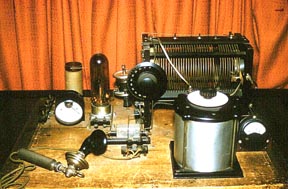
Earl C. Anthony's Home-Made Transmitter
Pat Bishop told the story of Mr. Anthony buying two of the first 50-watt tubes from RCA and
hand carrying them home. In the 1920's, many listeners hand built their own
radio receivers. These had the parts screwed to a wooden breadboard. The coils
were wound by hand. Earl C. Anthony built his first KFI transmitter the same
way. Over the years it was taken apart and the parts used for other things. For
the 1972 anniversary, Mr. Blatterman, Chief Engineer, posted a memo on our
bulletin board, requesting the return of all the missing parts especially the
hot wire ammeter. The board is reassembled and is put on display again.
KFI's signal is strong out over the ocean. One of Mr. Anthony's staff has a yacht.
There were sails to Hawaii and he wrote his song. "Oh Coral Isle."
That is said to be the reason that C is called Coral. Studio E is called
Emerald.
When Cox Broadcasting bought KFI, I had the opportunity to visit Mr.
Anthony's office. It is like an attic full of memories. He kept an upright
piano, a Grandfather clock and gifts from his Boy Scout Troop. He didn't keep
his old transmitter but here is an old 20's battery powered Western Electric receiver
and a Magnavox tin horn speaker.
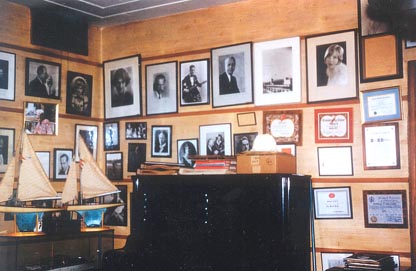
Earl C. Anthony's office
Here is his private viewing window. Uncovered,
it looks out to the auditorium studio with views of the stage.
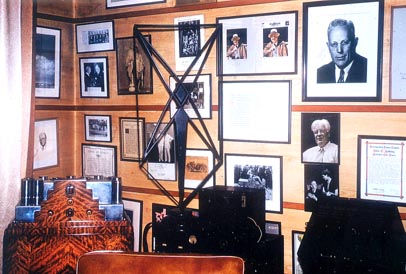
Earl C. Anthony's office
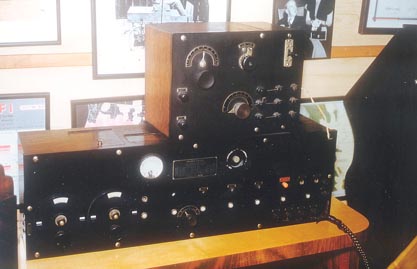
The Western Electric Receiver in Earl C. Anthony's office
Yearly E.C.A. sponsors his Scout troop to a hiking trip into the mountains. Our engineer
Harry Parker, on his own time I think, goes on the hike. He carries a heavy
pack-transmitter—KA 4711—to keep contact with the hikers. At a prearranged
place, ice cream treats are air dropped to the troop. We carried short reports
of the troops progress that were broadcast over KFI.
Mr. Anthony made some personal recordings, greetings to his family, very formal in style. "This
is Earl C. Anthony speaking."
Mr. Anthony is gone and I am sorting over his
things, before strangers throw them out. I am thinking that someone else will be
throwing out what I have saved, and it will be the same stuff: John Charles
Tomas, Souza and McArthur's farewell speech!
Mr. Anthony looked lonely. He was spared the tragedy of his son's death. His estate
went to his Alma Mater and other educators.
Like Henry Ford, he was paternalistic, treated his employees perhaps better than
did their Unions.
His namesake station, KECA, had to be de-vested, when the F.C.C.
ruled against the ownership of two stations in the same market. His was the
smallest corporation to own a T.V. channel (9).
I saw the Vermont sidewalk
filled with strikers, (his own employees included). It was too soon for T.V. to
make money. It was only finding its market. He sold KFI TV 9 soon after the
talent strike. The personal events of thirty three years at KFI, have made me
glad to have been Mr. Anthony's engineer, and not to have traded places with Mr.
Anthony himself.